Lecture 17 - Light and Optics (2/21/96)
Seeds: Chapter 5
- More on the Nature of Light
- The electric and magnetic forces from an electromagnetic wave,
such as visible light or radio waves, can be measured.
- A radio wave, with a wavelength of 1 meter for example, can
cause electrons in a wire of about that same length to move
back and forth due to the oscillating electric force in the wave.
These moving electrons are measureable as an electric current
in the wire - this is how a radio or TV antenna works to receive
signals!
- The electrons in the metal of the antenna (which is basically just
a long wire) are free to move a little in response to the radio wave
electric field. The current alternates like a sine wave.
- The reverse is also true! If you oscillate the current like a sine
wave in a long wire, an electromagnetic wave of the same frequency
is generated. This is how radio and TV transmitters work.
- The 19th century scientist who played an analogous role for electricity
and magnetism to what Isaac Newton did for gravity was the Scottish
physicist James Clerk Maxwell (1831-1879). His four equations
described the electic and magnetic forces just like Newton's
equation described the gravitational force.
- In fact, they are very similar. The electric force between two
point charges is proportional to the product of the charges times
the inverse square of the distances - just take Newton's gravitational
force equation and replace the masses with charges, and change the
constant! Note that because electric charge can be both positive and
negative, the force can both attract and repel (like charges repel,
opposites attract).
- Maxwell found that there was a special solution to his 4 equations
that corresponded to an oscillating electric and magnetic field
which moves through space at the speed of light. He realised that
this was exactly the description of light waves that was needed!
In one fell swoop, he unified electromagnetism and light!
- The Nature of Forces
- Once again, I will diverge from our discussion of astronomy to talk
a little of the nature of modern physics and our view of the universe.
- You have seen and heard me use the term field, as in electric
field, magnetic field, gravitational field, or just plain force field.
Technically speaking, a field is any quantity that has a
specific value at any point in space.
- If we place a mass such as the Sun somewhere in space, then take a
second mass such as the Earth and move it about, I would measure a
force on the Earth that depended on the distance from the Sun to
the point in space that I happened to place the Earth. Thus, we
can think of a gravitational field generated by the Sun's
mass such that at every point in space one would compute the correct
gravitational force on a mass at that position.
- The same thing can be said for an electric charge - it would
generate an electric field at each point in space whose
size was proportional to the charge times the inverse square of
the distance from the charge.
- If I can measure a force from a mass at every point in space, and
represent it as a gravitational or electric or magnetic field,
what does that really mean? How do forces get transmitted through
space from one mass or charge to another? If I change the mass of
the Sun, for example, does the force on the Earth instantly change?
- We belive that the fundamental forces of nature are transmitted from
one place to another through the intermediation of special particles
which travel at the speed of light.
- If you think about Maxwell's discovery for a bit, which says that
light waves are just electromagnetic waves, it seems logical that
electric and magnetic forces are transmitted by photons of light!
Basically, this is true, though of course it is more complicated
than just photons travelling between electric charges. It is beyond
the scope of this course to explain this in more detail.
- There are four fundamental forces in physics, each with their
intermediary particle:
- Electromagnetic Force - photon (electric and magnetic forces
on charged particles such as electrons and protons)
- Gravitational Force - graviton (gravitational force between
masses, this particle is as yet undiscovered)
- Strong Nuclear Force - gluon ("glues" together the quarks
that make up protons and neutrons, and hold the nucleus
together)
- Weak Nuclear Force - W, Z particles (causes some kinds of
radioactive decays, and governs creation of particles called
neutrinos)
- All the particles and forces make up our theory of physics called the
"standard model". This is our paradigm for the way the universe works.
- It is a very complicated theory now, with four forces and 12 (or more)
elementary particles. Many physicists are searching for a simpler
and more elegant theory, as it seems that the standard model looks
like a theory with too many "epicycles", just like the incorrect
Ptolemaic model.
- Elementary Optics
- We will use the term "ray" to represent the "path" of a light
wave or photon as it moves through space. It is not really the
path of a photon, since a single photon is also a wave that fills
space, but in some senses it is. It is also a line connecting the
light source to the point
in question that is always perpendicular to the wavefront of the
light. This seems confusing, but it is a useful conceptual tool
as we will see.
- There are three processes in elementary optics: reflection,
refraction, and dispersion.
- Reflection is just light bouncing off a shiny surface like
a mirror or glass. Stand in front of a mirror and move around and
look at different angles to it, and you will discover the law of
reflection: the angle that an incident light ray makes to the
normal of the reflecting surface is just the same as the
angle the reflected ray makes, and in the same plane.
- The normal is just a line perpendicular to the surface at the
point where the ray intersects the mirror.
- Summary: a light ray bounces off a mirror at the same angle that
it hits it, staying in the same plane.
- Refraction is what happens when light rays move from one
transparent material to another. It is a bending of light.
- A transparent material, like air, water, or glass, has an
index of refraction, which is the ratio of the speed of
light in a vacuum (3 x 10^8 m/s) to the speed of light in
the material, which is less. (Note: a vacuum is the absence
of all matter, or at least nearly all matter, like in outer space.)
- Clarification: the speed of light in a vacuum is the constant
c = 2.998 x 10^8 m/s. It is actually true that the
electromagnetic waves of light move at slower speeds in the
presence of matter. In general, the denser the material,
the slower the speed.
- The index of refraction is usually denoted by the symbol n.
The index of refraction in a vacuum, like space, is of course
n = 1. In some common materials: air (n = 1.0003),
water (n = 1.3), glass (n = 1.5), and diamond
(n = 2.4). When you look at a diamond, you should realise
that light moves less than half its normal speed when passing through
it!
- The law of refraction states that the angle that the ray in the
material with the higher index of refraction makes to the normal
at the interface is less than the angle to the normal in the material
with the lower index of refraction.
- Thus, a ray is bent toward the normal when it passes from air into
glass, for instance, but then is bent farther from the normal when
it passes from glass into air.
- Note that if you take a slab of glass with parallel faces, the
refraction from air into glass is undone exactly by the refraction
from glass into air! That is why smooth window panes give no
distortion while wavy glass would give a really bent and distorted
view of the outside.
- Also note that if we take a wedge of glass, where the faces are
not parallel, then the refractions at the interfaces do not cancel,
and we can see the bending of the rays.
- A lens is just a piece of refractive material, like glass, that
is shaped so that parallel rays in from one side are bent in such
a way that they cross at a focus on the other side. It turns
out that two spherically curved surfaces can make such a lens. This
is how a magnifying glass lens works.
- However, it turns out that the amount of the bending in a refractive
material usually depends upon the wavelength of the light. The
exact value of the index of refraction in a material such as glass
and water depends upon the wavelength of the light, such that
that shorter wavelengths see a higher index, and are bent more.
- This effect is called dispersion, since when passing through
a refractive interface between media the blue and red light rays are
bent differently and spread out in a "dispersed" fan on the other
side. This is why a wedge of glass makes a prism that will spread
out the different colors of light. This is also the effect that
makes colorful rainbows when sunlight is refracted through many tiny
droplets of water in rain!
- A dispersive optical element like a prism spreads light into its
composite
colors, or spectrum (think of the "electromagnetic spectrum").
A spectroscope is the technical name for such a device.
- Note that a curved mirror can also focus rays of light through
reflection - like a shaving mirror. Next time we will see how
to use lenses and mirrors to make useful telescopes.
Next Lecture -
Telescopes
Elementary Optics
The Law of Reflection:
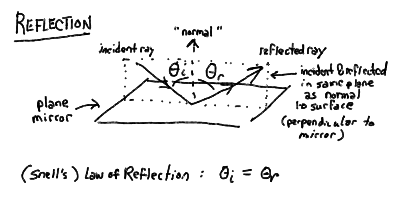
Refraction in a transparent medium:
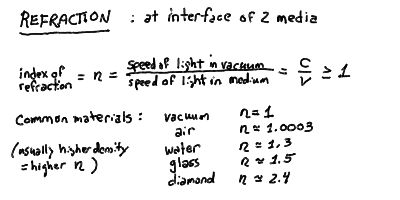
Bending of light rays at medium interface:
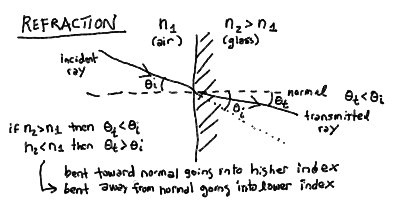
Lenses are shaped refractive materials:
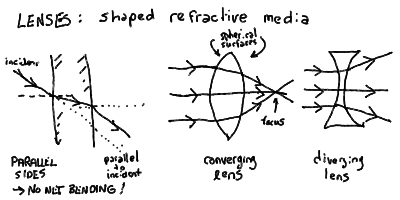
Dispersion is wavelength-dependent refraction:
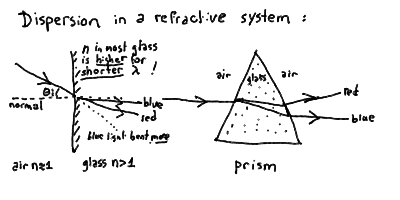
Go to Previous Lecture ----
Go to Next Lecture
Back to the Lecture Notes Index
Back to the ASTR001/Sec3 Page
Steven T. Myers - Last revised 26Feb96





